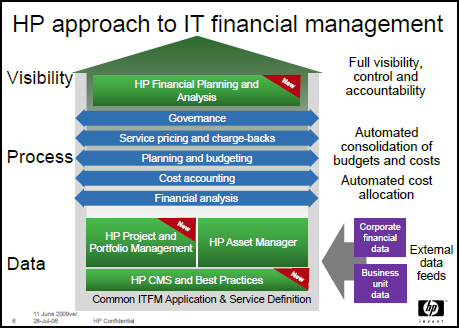HP connects IT investment, value, and transparency

Last week, I attended HP's Software Universe 2009 conference to participate on a panel discussion around success strategies for deploying project portfolio management (PPM). I used the opportunity to speak with HP executives about their vision for the future of PPM and its relationship to enterprise value creation.
To understand the company's PPM product direction, I spoke with four folks representing HP's views on features, strategy, and customer implementation:
- Paul Muller, VP for Strategic Marketing
- Ken Cheney, Director of Products, IT Financial Management
- Bruce Randall, Manager of Product Marketing, PPM
- John Wills, Practice Principal for HP's Business Intelligence Solutions group
HP's primary strategic message about the future direction of PPM involves helping IT departments improve their ability to quantify project costs, benefits, and derived value, which Paul described this way:
We automate the spreadsheet Kung Fu that IT often uses to analyze financial data. Our goal is reducing decision-making cycle times and creating transparency that quantifies the business value of IT operations.
Ken Cheney elaborated on this message:
Many organizations find it difficult to get an accurate handle on IT costs. We link IT with the business services it delivers and assign value to help IT appropriately price these services. The future of PPM is helping organizations clearly see the total cost of ownership of all IT services.
HP's strategy positions PPM as a building block in a broader IT financial management offering, as the following diagram illustrates:

HP's intention is to provide software and services that help its customers operate IT with the same level of business oversight and operating efficiency as practiced by other, usually non-technical, business areas.
THE PROJECT FAILURES ANALYSIS
This IT financial management strategy makes logical sense but also contains certain pitfalls about which potential customers should be wary.
In general, most non-IT organizations are well equipped to manage and analyze the costs they accrue and the benefits, or value, associated with those costs. ROI analysis is a standard measure of value, although there are certainly others, that aligns business investment with performance and outcome.
In contrast, IT has historically had a more difficult time than other corporate functions measuring value derived from investment. I suspect this arises both from IT's inherent complexity and its relatively recent entry as technologist to the corporate world. Computers are a recent development compared to double entry accounting, for example, which originated in the 15th century. Only in recent years has IT started achieving a level of process maturity approximating what already exists in other departments.
HP is taking a logical step toward helping IT professionalize its role in the business. These steps go beyond traditional commodity PPM. A Gartner project and portfolio management report dated, June 2, 2009, describes the commodity aspect of core PPM software functions:
[T]his year's Magic Quadrant reflects a transition from core PPM functions (now identified as commodities) to the connection of core PPM functions with a broader range of activities, and events incurring additional IT expense and consumption of resources and related to the support and maintenance of existing applications and IT services.
To gain additional perspective, I spoke with Brian Sommer, a project portfolio management expert and market analyst who's also a fellow blogger for ZDNet:
Although vendors have demonstrated new business models and delivery options, such as software as a service (SaaS), PPM software as a category has generally been lacking innovation in recent years. HP is innovating by helping IT better calculate and articulate the relationship between investment and value delivered back to the business.
Risks. Although HP's strategy is sound, it's not a silver bullet. As I spoke with HP customers at the conference, it became clear some are confused about the roles of software tools and organizational process in accomplishing their goals.
It's far easier to market and sell packaged tools than it is explain the organizational changes required to make best use of that software. Brian is concerned that not all customers possess the financial sophistication required to take advantage of HP's vision:
Some IT organizations will be hard-pressed even to understand how to use these tools, let alone implement them properly. Achieving desired results from software requires good source data, which has always been the Achilles heel of project management solutions. In that sense, not much has changed.
Although you can't automate financial savvy and good business capabilities, this solution will be very helpful to those who understand the financial issues. HP is going in the right direction.
My take. HP offers broad capability and solid infrastructure for mature organizations possessing the financial understanding and willingness to invest in people and process. Most organizations, especially smaller ones, will prefer to take bite-sized steps and implement pieces of the solution, perhaps growing their deployment over time. HP offers resources to help committed customers achieve the organizational maturity required to take full advantage of this offering.
[Disclosure: HP reimbursed my out of pocket travel expenses associated with attending this conference.]